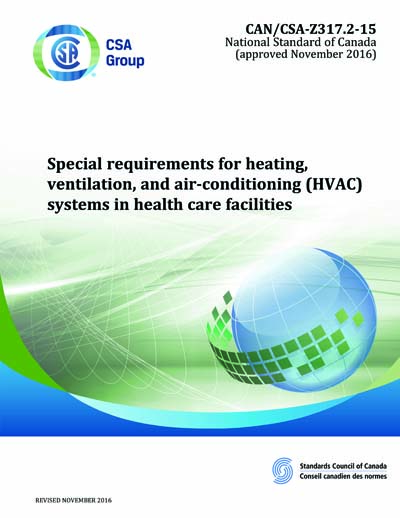Historical
CSA Z317.2-2015
Z317.2-15 - Special requirements for heating, ventilation, and air-conditioning (HVAC) systems in health care facilities
Preface
This is the fourth edition of CSA Z317.2, Special requirements for heating, ventilation, and air- conditioning (HVAC) systems in health care facilities, one of a series of Standards on the design, construction, and maintenance of health care facilities and systems. It supersedes the previous editions, published in 2010, 2001, and 1991. This Standard is intended for use by architects, engineers, planners, consultants, and health care facility staff to ensure the efficient design, construction, and maintenance of HVAC systems. In addition to design and construction requirements, this Standard includes operational, maintenance, and monitoring requirements for HVAC systems that will reduce the risk of transmission of infection among building occupants, including patients, staff, and visitors. Significant changes in this edition include the following: a) Revised definition of health care facility and division of Class C facilities into Class C-1 and Class C-2, to address the increasing number of surgical and other significant clinical procedures taking place outside of the traditional hospital setting; b) Increased use of performance requirements in place of prescriptive design specifications, particularly with respect to system redundancy; c) Updated values for temperature, humidity, and relative pressurization in Table 1; d) Additional material on HVAC cooling towers; e) Alignment of Clause 7 material on commissioning with CSA Z8001; f) Alignment of Clause 8 material on operation, monitoring, and maintenance with CSA Z8002; g) New provisions for reduced operation of HVAC systems during unoccupied periods; h) Revisions to Clause 5.8 requirements for system upgrades associated with health care facility renovations or additions; i) Revised requirements for system design capacities to respond to catastrophic events; j) Updated requirements for energy efficiency; k) Revised requirements for acoustic materials used for the lining of system components; and l) Revised acoustic requirements for HVAC equipment and systems. CSA Group acknowledges that the development of this Standard was made possible, in part, by the financial support of the governments of Alberta, British Columbia, Manitoba, New Brunswick, Newfoundland and Labrador, Northwest Territories, Nova Scotia, Nunavut, Ontario, Prince Edward Island, Québec, Saskatchewan, and Yukon, as administered by the Canadian Association for Drugs and Technology in Health (CADTH).Scope
1.1 This Standard provides requirements for the planning, design, construction, commissioning, operation, and maintenance of HVAC systems in HCFs. In general, these requirements are more stringent than those applied to non-health-care facilities. Note: See Annex A for general guidelines on HVAC system design. Table 1 provides specific design parameters for HVAC systems. 1.2 This Standard a) specifies minimum values for certain parameters; b) establishes the suitability of different design options; c) establishes recommendations for zoning, controls, and monitoring; and d) outlines best practice for energy conservation. 1.3 This Standard is not intended to preclude the use of design concepts and the adoption of installation, operations, and maintenance procedures more stringent than those specified in this Standard. In cases where clinical evidence supports additional measures to improve the safety and efficacy of HCFs, such additional measures should be considered in the design, installation commissioning, operation, and maintenance of the HVAC system. 1.4 This Standard applies to new buildings, additions to existing buildings, and alterations to existing buildings. Alterations include changes in function or size of spaces and the rearrangement, replacement, or addition of HVAC equipment, but do not include routine maintenance and service. Note: Like for like replacement of worn or failed components is generally considered to be routine maintenance; however, a more in-depth analysis should take place when replacing major components. See Clause 5.8.4. 1.5 This Standard does not address requirements for other elements of a building that are not directly a part of the HVAC system but can affect the design, performance, or operation of these systems, including but not limited to a) building envelope; b) structure; c) electrical power and lighting systems; d) plumbing system; and e) fire protection system. 1.6 In this Standard, shall is used to express a requirement, i.e., a provision that the user is obliged to satisfy in order to comply with the standard; should is used to express a recommendation or that which is advised but not required; and may is used to express an option or that which is permissible within the limits of the Standard. Notes accompanying clauses do not include requirements or alternative requirements; the purpose of a note accompanying a clause is to separate from the text explanatory or informative material. Notes to tables and figures are considered part of the table or figure and may be written as requirements. Annexes are designated normative (mandatory) or informative (non-mandatory) to define their application.Content Provider
CSA America, Inc. [csa]






